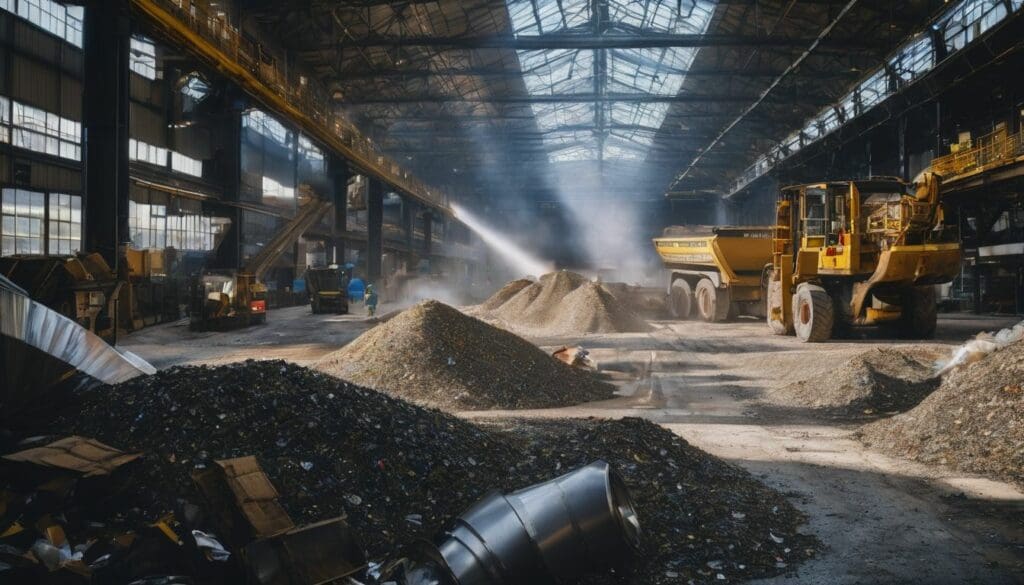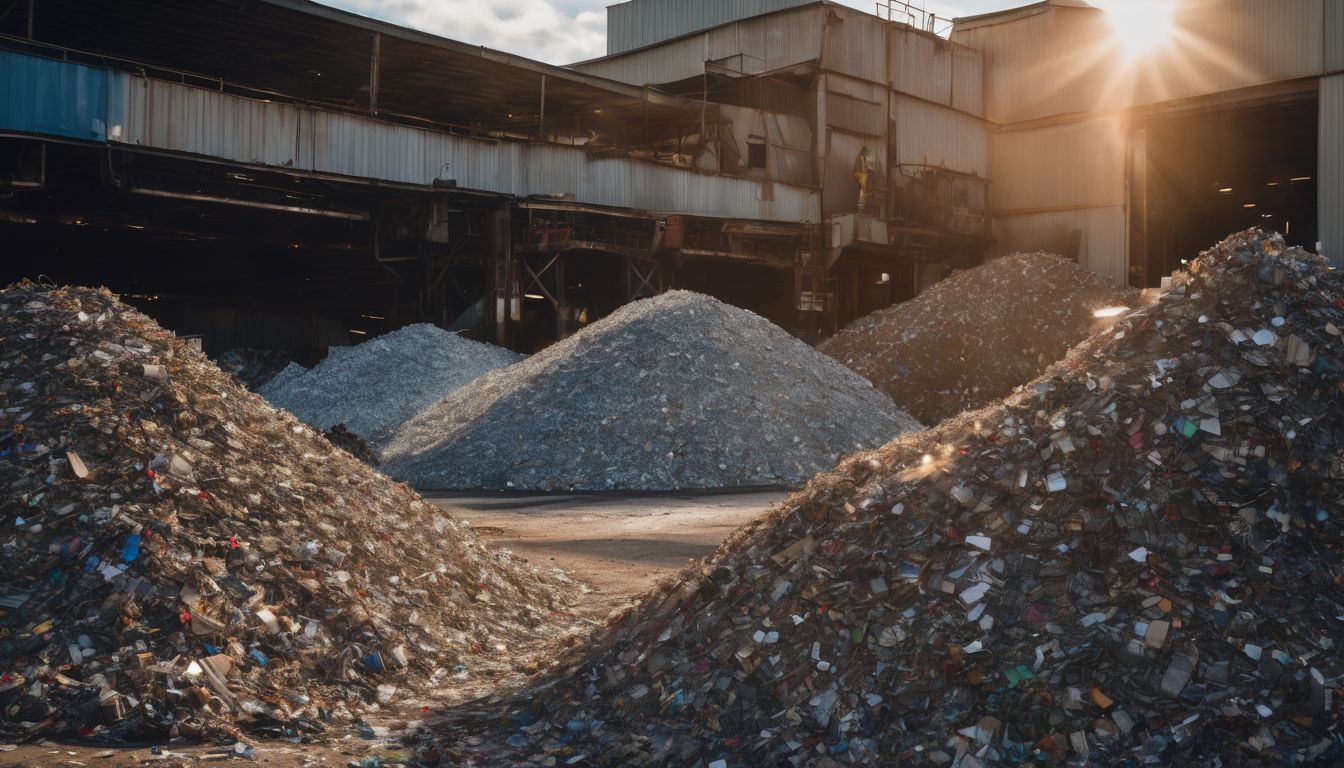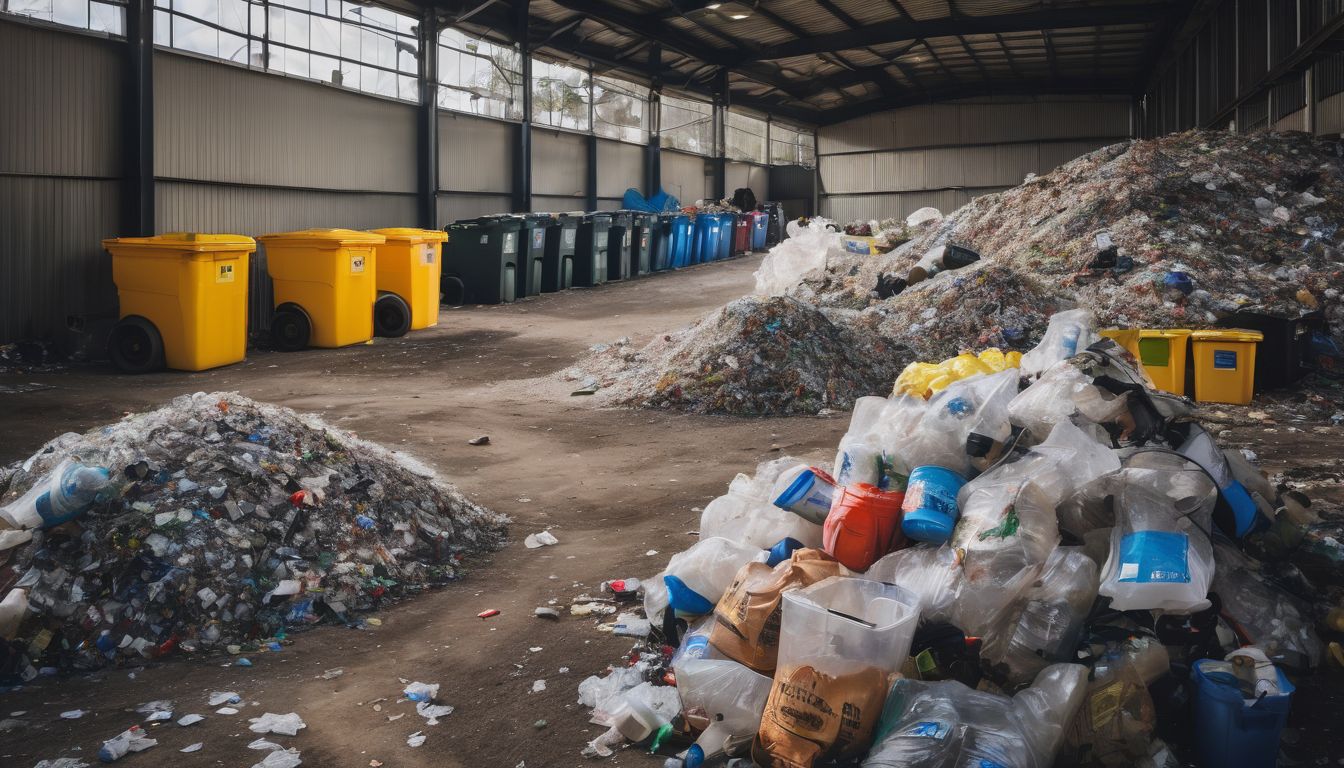We all want to help the planet, but figuring out what happens after we recycle can be a mystery. Did you know that a glass bottle can go from your recycling bin to back on the shelf in just 30 days? Our blog takes you on an eye-opening tour of how everyday items transform into new products, showing you each step of their green journey.
Keep reading and become a recycling expert!
Key Takeaways
- Recyclable materials like glass, paper, metal, and plastic undergo a detailed process including collection, sorting by type and color, cleaning to eliminate contaminants, shredding into smaller parts for processing, and eventually transforming into new products.
- Glass recycling is energy – efficient and maintains quality even after numerous cycles; recycled paper saves trees and reduces landfill waste; metals are melted down and reformed reducing the need for mining; plastics become various products lessening dependence on virgin resources.
- Transport routes during recycling are optimised to reduce carbon emissions. Recycling companies work closely with local councils to ensure efficient collection systems that support environmental conservation efforts.
- Proper sorting of recyclables is essential in preventing contamination at recovery facilities which ensures high-quality materials for repurposing while minimising waste sent to landfills.
- Innovations in sustainable materials such as bioplastics and 3D printing technologies pave the way for future green advancements. This progress promotes responsible consumption patterns among individuals who choose eco-friendly product alternatives.
The Recycling Process
Recycling involves several stages, from collection and transportation to sorting, cleaning, shredding, pulping, processing and transformation into new products. The journey of recyclable materials is a complex process that requires careful handling and sustainable practices.
Collection and Transportation
Collection and transportation are crucial steps in the journey of recyclable materials. They involve gathering discarded items and moving them to facilities where they can begin a new life.
- Local councils organise kerbside pickups to collect recyclables from households and businesses.
- Waste management workers separate general waste from recycling to prevent contamination.
- Special trucks equipped for handling recyclables transport the materials to sorting centres.
- These vehicles are designed to compact items, saving space and maximising efficiency during transit.
- At transfer stations, smaller loads combine into larger ones for economic shipment to material recovery facilities.
- Environmental conservation efforts ensure that transport routes are optimised for reduced carbon emissions.
- Recycling companies often collaborate with local authorities to streamline collection schedules based on community needs.
- Each type of material, such as paper or glass, may have its own bin to simplify the sorting process later on.
Sorting and Cleaning
At recycling facilities, recyclable materials are sorted and cleaned before they undergo further processing.
- Materials are sorted by type to ensure that each category is properly processed.
- The sorting process involves separating materials such as glass, paper, metal, and plastic from one another.
- Once separated, the materials are thoroughly cleaned to remove any contaminants or impurities.
- Cleaning ensures that the recycled materials meet quality standards for manufacturing new products.
- This meticulous sorting and cleaning process is crucial for producing high-quality renewable products.
Shredding and Pulping
- Shredding: Large items such as plastic bottles or cardboard boxes are shredded into small, uniform pieces to prepare them for further processing.
- Pulping: This process involves mixing the shredded materials with water to create a pulp, which is then cleaned and refined to remove contaminants.
- Fibre Separation: In the case of paper recycling, pulping separates the paper fibres from ink and other impurities, creating a clean pulp material ready for reuse.
- Material Homogenisation: The resulting pulp undergoes blending to ensure a consistent quality before it is sent for manufacturing new products.
- Quality Control: Throughout shredding and pulping, strict quality control measures are implemented to maintain the integrity of the materials being processed.
- Environmental Impact: Shredding and pulping reduce waste in landfills and lower the need for raw materials, contributing positively to environmental stewardship and sustainable living efforts.
Processing and Transformation
Once the recyclable materials have been shredded and pulped, they undergo processing and transformation to turn them into new products. This step involves several crucial processes:
- Melting and Reforming: The shredded materials are melted down and reformed into raw materials.
- Moulding and Shaping: The molten materials are moulded and shaped into the desired form for manufacturing new products.
- Mixing and Compounding: Different types of recycled materials may be mixed together to create composite materials with enhanced properties.
- Quality Control Testing: The newly formed materials undergo rigorous testing to ensure they meet quality standards for use in manufacturing.
- Manufacturing New Products: These processed raw materials are used in the production of a variety of new products, such as containers, packaging, textiles, and more.
- Incorporating Sustainable Design: Manufacturers strive to integrate sustainable design principles into the production process to minimise waste and maximise resource efficiency.
Manufacturing New Products
Manufacturing new products from recycled materials is an essential stage of the recycling process. This step involves transforming raw recycled materials into usable items.
- Grind and Melt: The recycled materials are ground into small pieces and then melted down to form new raw material.
- Refining: The molten material undergoes refining to remove impurities and enhance its quality.
- Molding and Shaping: The refined material is molded and shaped into the desired product using innovative techniques.
- Quality Control: Rigorous quality control measures are carried out to ensure the final product meets industry standards.
- Packaging: The finished products are packaged sustainably for distribution, maintaining eco-friendly practices throughout the process.
- Distribution: The newly manufactured products are distributed to retailers or directly to consumers, completing the journey from bin to new product.
Back on the Shelves
After going through the recycling process, materials like glass, paper, metal, and plastic are transformed into new products. These items find their way back on the shelves as eco-friendly alternatives that have been repurposed from recycled materials.
The upcycling processes play a vital role in sustainable manufacturing and resource recovery by reusing resources instead of using raw materials to create new products.
Manufacturing new items from recycled materials reduces the demand for virgin resources while minimising waste and pollution. By supporting products made from recyclable materials, individuals can actively contribute to environmental conservation efforts.
The Journey of Recyclable Materials
From the bin to new products, recyclable materials like glass, paper, metal, and plastic go through a journey of sorting and separating, repurposing and transforming before they can be used again.
Each material has its own unique path towards becoming a new product.
Glass
Glass is a versatile material that can be endlessly recycled without losing its quality. Once collected, glass is sorted by colour and then cleaned to remove any impurities. The glass is then crushed into small pieces and melted down to make new products such as bottles and jars.
This process saves energy because making products from recycled glass requires less energy compared to producing new materials.
Glass recycling plays a vital role in reducing the amount of waste sent to landfills while conserving natural resources. By repurposing glass, we help reduce air pollution, save raw materials, and energy usage associated with producing new containers.
Paper
To recycle paper, it undergoes a series of steps. Firstly, collection trucks gather used paper from bins and deliver them to recycling facilities. Next, the papers are sorted into different categories and cleaned thoroughly to remove any contaminants.
After that, the cleaned paper is shredded and pulped to break it down into fibers. Then, the pulp is processed and transformed into new paper products by pressing and drying it into sheets or rolls.
Finally, the newly formed paper products are distributed back onto store shelves for consumers who prefer eco-friendly options.
Metal
Metal recycling is a crucial part of the journey from bin to new product. Recycling infrastructures reprocess metal items by melting and moulding them into new products, reducing the reliance on raw materials.
This process saves energy as well as natural resources, making it an environmentally friendly option. By repurposing metal, we can cut down on waste in landfills and decrease the need for intensive mining activities.
Proper sorting of metals such as aluminium and steel is essential to ensure that they are recycled efficiently.
Plastic
Plastic recycling begins with collection and transportation to a recycling facility. Once there, the plastic is sorted by type and colour before being cleaned to remove contaminants.
The next step involves shredding the plastic into small flakes or pellets, which are then melted down to form new products. These recycled plastics can be transformed into a wide range of items such as bottles, containers, clothing, and even furniture.
By repurposing materials like plastic in this way, we reduce waste while conserving natural resources.
The Role of Recycling Companies
NCM Recycling and Waste Solutions plays a crucial role in the recycling process by providing the infrastructure and expertise needed to collect, sort, clean, and process recyclable materials.
Their efforts contribute to reducing waste and environmental impact.
NCM Recycling and Waste Solutions
NCM Recycling and Waste Solutions processes a wide range of recyclable materials, including glass, paper, metal, and plastic. The company collects and transports these materials to their facilities for sorting, cleaning, and processing.
Once the materials are shredded and pulped, NCM Recycling transforms them into new products through innovative manufacturing techniques. The end result is high-quality items that find their way back onto the shelves as sustainable alternatives.
To support conservation efforts and environmental sustainability, environmentally conscious individuals can actively engage with companies like NCM Recycling and Waste Solutions who play a vital role in the circular economy by giving discarded materials a new lease on life.
The Importance of Proper Sorting
Proper sorting of recyclable materials is crucial for the success of the recycling process. When materials are sorted correctly, it ensures that each type can be processed efficiently and effectively.
This means that different types of glass, paper, metal, and plastic can be sent to their respective recycling plants without contamination or confusion. Proper sorting also helps in reducing the amount of waste that ends up in landfills by allowing a higher percentage of materials to be successfully recycled into new products.
The significance of proper sorting lies in its ability to maintain the quality and purity of recyclable materials throughout the recycling journey, promoting a sustainable and environmentally friendly ecosystem.
It also facilitates smoother operations at recycling facilities while contributing towards creating new products from recycled material.
Moving on to “6. Beyond Recycling: The Future of Sustainable Materials”, let’s explore how various industries can lead the way in sustainability beyond traditional forms of recycling.
Beyond Recycling: The Future of Sustainable Materials
Innovations in sustainable materials are shaping the future of recycling. Companies are developing new methods to create eco-friendly products from recyclable materials, reducing the reliance on raw resources and minimising waste.
Cutting-edge technologies such as bioplastics made from plants, and 3D printing with recycled materials, offer exciting possibilities for a more sustainable future. These advancements not only promote environmental conservation but also encourage individuals to take active steps towards a greener lifestyle by supporting products that contribute to a circular economy.
Businesses are increasingly investing in research and development to incorporate sustainable practices into their operations. This signifies a broader shift towards creating a closed-loop system where materials can be repurposed repeatedly without compromising quality or integrity.
The focus is on not just being environmentally friendly but also making sustainability an integral part of our everyday lives through innovative product design and material sourcing strategies.
Conclusion
In conclusion, recyclable materials take a remarkable journey from the bin to becoming new products. The recycling process involves collection, sorting, cleaning, shredding, and manufacturing.
Through the role of dedicated recycling companies, like NCM Recycling and Waste Solutions, these materials are transformed into valuable resources. Proper sorting is crucial for effective recycling and beyond that lies the exciting future of sustainable materials.
FAQs
1. What happens to recyclable materials after we put them in the bin?
Once you toss recyclable materials into the bin, they are collected and taken to a recycling center where they are sorted, cleaned, and prepared for the journey to become new products.
2. How do recyclables get turned into new products?
After sorting, the clean recyclable materials are broken down and transformed into raw material that manufacturers use to create brand new items.
3. Can all items thrown in recycling bins be recycled into new products?
Not everything in recycling bins can be recycled. Only materials that are accepted by local recycling programs will complete the journey from bin to becoming part of a new product.
4. Why is it important to recycle properly?
Recycling properly ensures that recyclable materials make their way through the journey efficiently so they can be reused, reducing waste and helping our environment.





